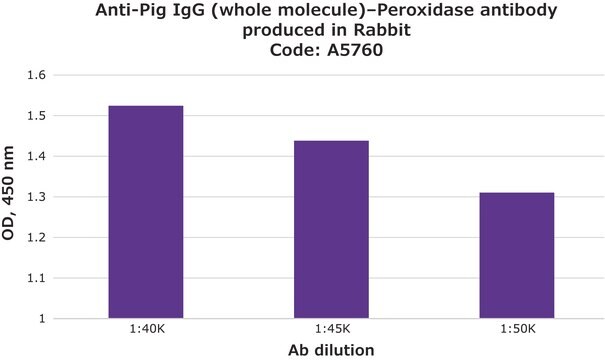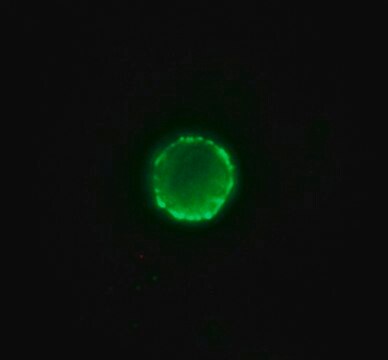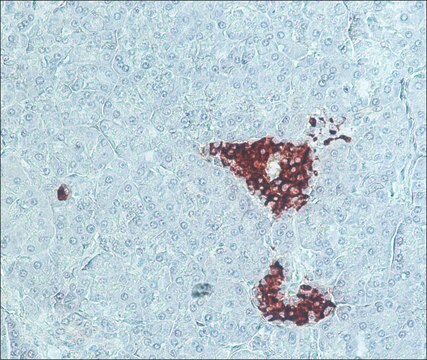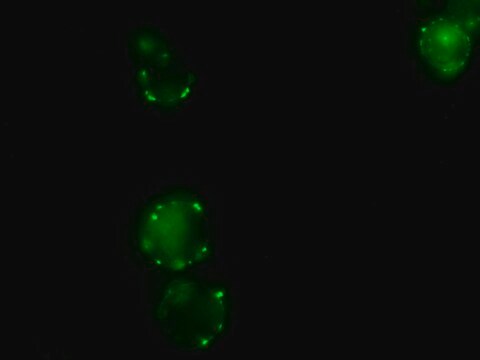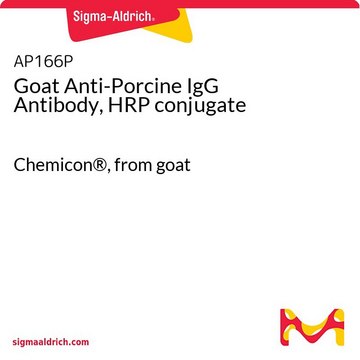推薦產品
生物源
rabbit
品質等級
共軛
unconjugated
抗體表格
whole antiserum
抗體產品種類
secondary antibodies
無性繁殖
polyclonal
包含
15 mM sodium azide
技術
indirect ELISA: 1:40,000
quantitative precipitin assay: 2.8 mg/mL
運輸包裝
dry ice
儲存溫度
−20°C
目標翻譯後修改
unmodified
尋找類似的產品? 前往 產品比較指南
一般說明
Immunoglobulin is a glycoprotein, with two heavy chain and two light chain connected by disulfide bond. IgG is a major class of immunoglobulin. IgG has five subclasses, such as- IgG1, IgG3, IgG2a and IgG2b.
特異性
The antiserum is determined to be immunospecific for pig IgG.
應用
Anti-Pig IgG (whole molecule) antibody produced in rabbit has been used in enzyme linked immuno sorbent assay (ELISA) and quantitative precipitin assay.
Anti-Pig IgG (whole molecule) antibody produced in rabbit has been used in radial immunodiffusion and single radial immunodiffusion.
生化/生理作用
IgG antibody provides protection from infections caused by bacteria, fungi and viruses. Maternal IgG is transferred to fetus through the placenta that is vital for immune defense of the neonate against infections.
Immunoglobulin G (IgG) participates in hypersensitivity type II and type III. It mainly helps in immune defense.
外觀
Supplied as a liquid containing 15 mM sodium azide as preservative.
準備報告
treated to remove lipoproteins
儲存和穩定性
For continuous use, store at 2-8 °C for up to one month. For extended storage, the solution may be frozen in working aliquots. Repeated freezing and thawing is not recommended. Storage in "frost-free" freezers not recommended. If slight turbidity occurs upon prolonged storage, clarify the solution by centrifugation before use.
免責聲明
Unless otherwise stated in our catalog or other company documentation accompanying the product(s), our products are intended for research use only and are not to be used for any other purpose, which includes but is not limited to, unauthorized commercial uses, in vitro diagnostic uses, ex vivo or in vivo therapeutic uses or any type of consumption or application to humans or animals.
未找到適合的產品?
試用我們的產品選擇工具.
儲存類別代碼
10 - Combustible liquids
水污染物質分類(WGK)
nwg
閃點(°F)
Not applicable
閃點(°C)
Not applicable
Relationships between passive absorption of immunoglobulin G by the piglet and plasma concentrations of immunoglobulin G at weaning
Rooke JA, et al.
Livestock Production Science, 81(2), 223-234 (2003)
A Socha-Banasiak et al.
Journal of biological regulators and homeostatic agents, 31(1), 87-92 (2017-03-25)
Preterm human neonates, contrary to preterm piglets, obtain immunoglobulins from their mothers via the placenta during intrauterine development. However, one should note that the majority of trans-placental transfer of immunoglobulins in humans takes place during the last trimester of pregnancy.
Kateryna Goncharova et al.
PloS one, 12(6), e0180002-e0180002 (2017-06-29)
Neurological disorders are among the main clinical problems affecting preterm children and often result in the development of communication and learning disabilities later in life. Several factors are of importance for brain development, however the role of immunoglobulins (passive immunity
Kateryna Pierzynowska et al.
Journal of immunology research, 2020, 3813250-3813250 (2020-02-25)
The current study is aimed at highlighting the impact of enterally or parenterally applied immunoglobulins (Igs) on polyunsaturated fatty acid (PUFA) absorption in newborn pigs. Piglets were chosen as the appropriate model since they are born agammaglobulinemic and any effects
S Hashira et al.
Pediatrics international : official journal of the Japan Pediatric Society, 42(4), 337-342 (2000-09-15)
Maternal immunoglobulin G (IgG), transferred across the placenta to the fetus during intrauterine life, is an important component of the neonatal immunological defence mechanisms against infection. There is controversy with respect to differences in placental transfer of the different IgG
我們的科學家團隊在所有研究領域都有豐富的經驗,包括生命科學、材料科學、化學合成、色譜、分析等.
聯絡技術服務